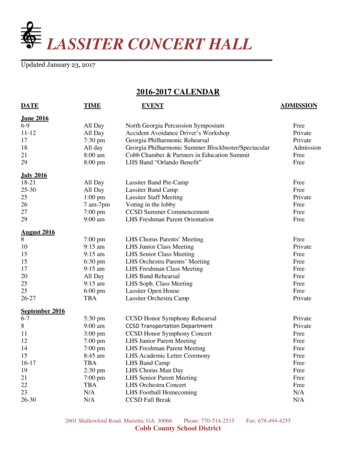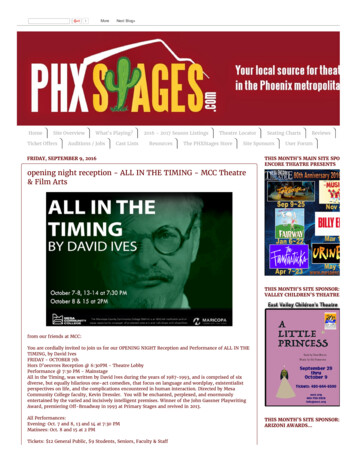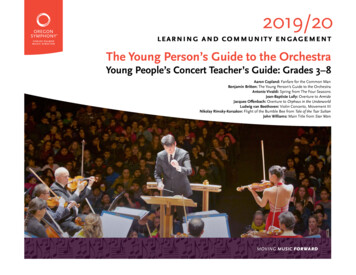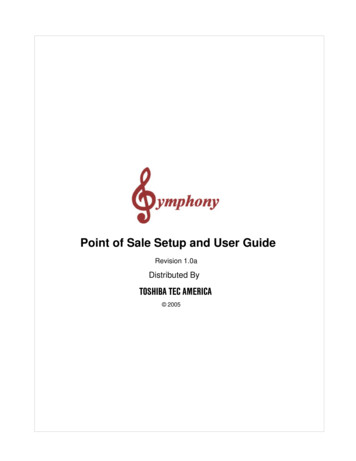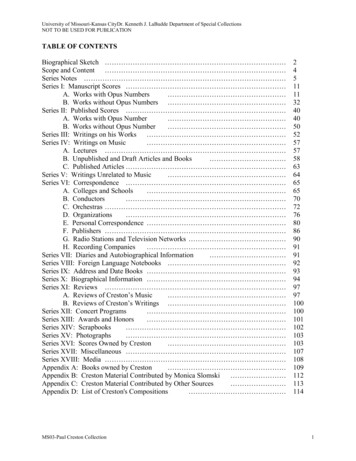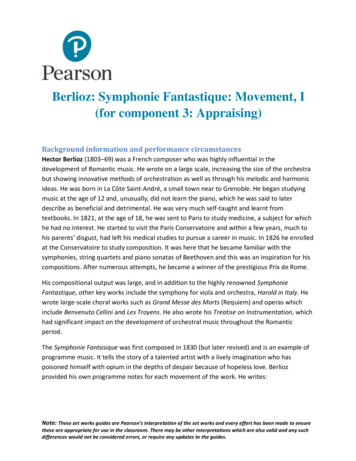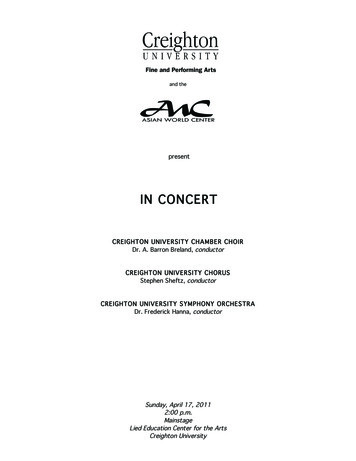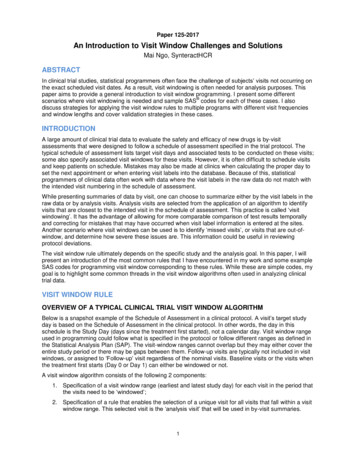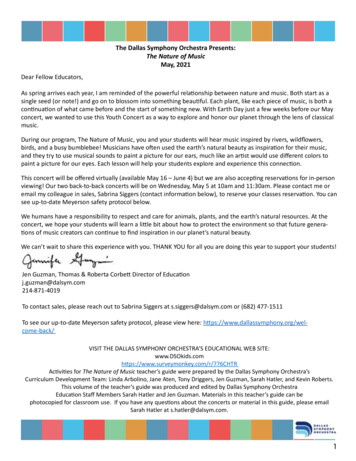
Transcription
The Dallas Symphony Orchestra Presents:The Nature of MusicMay, 2021Dear Fellow Educators,As spring arrives each year, I am reminded of the powerful relationship between nature and music. Both start as asingle seed (or note!) and go on to blossom into something beautiful. Each plant, like each piece of music, is both acontinuation of what came before and the start of something new. With Earth Day just a few weeks before our Mayconcert, we wanted to use this Youth Concert as a way to explore and honor our planet through the lens of classicalmusic.During our program, The Nature of Music, you and your students will hear music inspired by rivers, wildflowers,birds, and a busy bumblebee! Musicians have often used the earth’s natural beauty as inspiration for their music,and they try to use musical sounds to paint a picture for our ears, much like an artist would use different colors topaint a picture for our eyes. Each lesson will help your students explore and experience this connection.This concert will be offered virtually (available May 16 – June 4) but we are also accepting reservations for in-personviewing! Our two back-to-back concerts will be on Wednesday, May 5 at 10am and 11:30am. Please contact me oremail my colleague in sales, Sabrina Siggers (contact information below), to reserve your classes reservation. You cansee up-to-date Meyerson safety protocol below.We humans have a responsibility to respect and care for animals, plants, and the earth’s natural resources. At theconcert, we hope your students will learn a little bit about how to protect the environment so that future generations of music creators can continue to find inspiration in our planet’s natural beauty.We can’t wait to share this experience with you. THANK YOU for all you are doing this year to support your students!Jen Guzman, Thomas & Roberta Corbett Director of Educationj.guzman@dalsym.com214-871-4019To contact sales, please reach out to Sabrina Siggers at s.siggers@dalsym.com or (682) 477-1511To see our up-to-date Meyerson safety protocol, please view here: https://www.dallassymphony.org/welcome-back/VISIT THE DALLAS SYMPHONY ORCHESTRA’S EDUCATIONAL WEB /776CHTRActivities for The Nature of Music teacher’s guide were prepared by the Dallas Symphony Orchestra’sCurriculum Development Team: Linda Arbolino, Jane Aten, Tony Driggers, Jen Guzman, Sarah Hatler, and Kevin Roberts.This volume of the teacher’s guide was produced and edited by Dallas Symphony OrchestraEducation Staff Members Sarah Hatler and Jen Guzman. Materials in this teacher’s guide can bephotocopied for classroom use. If you have any questions about the concerts or material in this guide, please emailSarah Hatler at s.hatler@dalsym.com.1
Table of ContentsConcert specific informationYouTube PlaylistWho’s WhoComposer Biographies2p. 3p. 4p. 6Pre-Concert ActivityStrategies for Mindful Listeningp. 10Concert Activities1. Busy Bee at the Symphony2. The Power of Imagination3. Describing Descriptive Music - Absolutely!4. Nature as Inspiration5. Sounds from Strings6. Can You Hear the Seasons?p. 11p. 13p. 15p. 17p. 20p. 22Post-Concert ActivityFlat BeethovenStudent reviewp. 24p. 25
YouTube PlaylistYou will notice that we have moved from physical CDs to a digital playlist this year in an effortto make the music as accessible as possible for you. In the following lessons of this TeacherGuide, the playlist will be referenced and can be found here:https://www.youtube.com/playlist?list PLIn1z eTQBcGlpqnPOaPZTvgAXWO1IkJbThe tracks in this playlist include repertoire that will be performed at the Youth Concert youand your students will be watching, so we encourage you to listen to these pieces tofamiliarize yourselves with the music.1. Antonio Vivaldi –The Four Seasons: Violin Concerto in E Major, Op. 8, No. 1, "Spring": I. Allegro2. Hilary Tann - Water's Edge, II. From the Riverbed3. Ludwig van Beethoven -Symphony No. 6, "Pastoral," 3rd movement4. Ludwig van Beethoven - Symphony No. 6, "Pastoral," 4th movement5. Edward MacDowell - Ten Woodland Sketches, Op. 51: 1. To a Wild Rose6. Nikolai Rimsky-Korsakov - The Flight of the Bumblebee7. Bruce Patti - Winter's Walk3
Who’s WhoAustrian conductor Katharina Wincor, recipient of the Neeme Järvi Prize at the Gstaad Menuhin Festival in 2017, was born in 1995and trained as a pianist and oboist while attending the Senior HighSchool of Music, Linz (Austria). She studied composition at theAnton Bruckner Private University in Linz from 2009 to 2014.In 2017, she was invited by Riccardo Muti to be the youngest offive participants at his Italian Opera Academy, and in 2018 shewas invited as the youngest competitor of the world-renownedDonatella Flick LSO Conducting Competition in London. Wincor iscurrently preparing to conduct Tonhalle Orchester Zürich in a masterclass with David Zinman and attend the Aspen Music Festivaland School as a Conducting Fellow in summer of 2019.Recent notable projects include working as the Assistant ChorusMaster for Arnold Schoenberg Choir Vienna from 2016 to 2018 and assisting Mirga Gražinytė-Tyla at the Salzburg State Theatre.In masterclasses, competitions and concerts, Wincor has conducted the City of Birmingham Symphony Orchestra, MDW Chamber Orchestra Vienna, Mozarteumorchester Salzburg,Kurpfälzisches Kammerorchester Mannheim, Gstaad Festival Orchestra, Orchestra GiovanileLuigi Cherubini, Thüringen Philharmonie Gotha-Eisenach, Pazardzhik Symphony Orchestra,Meininger Hofkapelle and the BBC Concert Orchestra.Since 2014, Wincor has studied Orchestral Conducting in Vienna at the University of Music andPerforming Arts with Professor Mark Stringer, and was invited to study as an exchange studentat the Franz Liszt Weimar School of Music for the 2017/18 school year. She is currently continuing her studies at the Zurich University of the Arts with Professor Johannes Schlaefli. Wincorhas participated in masterclasses with Marin Alsop, Bernard Haitink and Jaap van Zweden.In 2012, Wincor founded her own choir, Bunte Steine, which has won national and international competitions, and with whom she works regularly.4
Gary Levinson is the Senior Principal Associate Concertmaster of the Dallas Symphony Orchestra and theArtistic Director of the Chamber Music Society of FortWorth. Chosen by Zubin Mehta to join the New YorkPhilharmonic before the completion of his undergraduate degree from the Juilliard School in 1988, Mr. Levinson made his New York Philharmonic solo debut in 1991,under the baton of Erich Leinsdorf, coinciding with thecompletion of his Master’s of Music degree at the Juilliard School, where his teachers included Dorothy DeLay,Glenn Dicterow and Felix Galimir.Born in St. Petersburg, Russia, Levinson began studyingthe violin at the age of five with Professor Sergeev at the Leningrad Special Music School. Afterimmigrating to the United States in 1977, he won the top prize at the 1986 Romano RomaniniInternational Violin Competition in Brescia, Italy, as well as becoming the top American Prizewinner at the 1987 Jacques Thibaud International Violin Competition in Paris, France.As a soloist, Mr. Levinson has collaborated with Erich Leinsdorf, Robert Spano, Jaap van Zweden, Miguel Harth-Bedoya and many others. Much sought-after as a chamber musician, Mr.Levinson has collaborated with Yo-Yo Ma, Lynn Harrell, Eugenia Zukerman, Lukas Foss, CarterBrey, Joseph Kalichstein and Christopher O’Riley.A champion of contemporary music, Mr. Levinson commissioned and performed the worldpremiere performance of George Tsontakis Violin Concerto No. 3 in 2020. Hrecorded the Margaret Brouwer Violin Concerto under the baton of 2012 Musical America’s Conductor of theYear, Jaap van Zweden in 2012. He premiered and recorded several works dedicated to Mr.Levinson by award winning Iranian composer, Behzad Ranjbaran. In 1996 he, along with hisfather, renowned double bassist Eugene Levinson, recorded the world premiere for CALA Records of Dances of Life, a bass and violin duo, written for and dedicated to the Levinsons. Mr.Levinson also collaborated with New York Philharmonic Principal English Hornist Thomas Stacyin a CD for CALA’s New York Legends series.Mr. Levinson performs on an Antonio Stradivari violin, crafted in 1726. It is graciously madeavailable for his use by the Dallas Symphony Association.5
Composer BiographiesLudwig van Beethoven (1770-1827) grew up in Bonn, Germany,in a very unhappy home. He was forced to practice the piano byhis father, who would punish him mercilessly when he made mistakes. By the time he was twelve, he was earning a living for hisfamily by playing organ and composing. He was eventually knownas the greatest pianist of his time. One of Beethoven's favoritefoods was macaroni and cheese. He also loved strong coffee exactly 60 coffee beans to one cup.Beethoven never married (he had a rather nasty temper), but inspite of his unpleasant personality, Beethoven will beremembered forever for his music.His first two symphonies are very much in the same style and form as those of composers thatcame before him, most notably Franz Joseph Haydn, his teacher. But Beethoven's writing- asseen in his Symphony No. 3- went in new directions. Named Eroica (Italian for "heroic"), hisSymphony No. 3 was so different from the ones that had come before that it changed musicforever. Its originality and innovation even inspired others to change the way that they composed. It was originally dedicated to Napoleon Bonaparte. But when Beethoven heard thatNapoleon had proclaimed himself Emperor, he went into a rage and destroyed the title page.Beethoven conducted the premiere of his Symphony No. 5 in C minor, Op. 67, in 1808 inVienna, and its opening four note motif may be the most recognizable motif in classical musictoday. A few years later, his Symphony No. 7 was an immediate success and was performedthree times in the 10 weeks following its premiere.Although Beethoven gradually lost his hearing, he continued composing. He composed many ofthe most famous musical works of all time, such as his Symphony No. 9 after he hadbecome totally deaf.6
Edward MacDowell (1860 – 1908) was born in NewYork City and began playing piano as a child. His motherbrought him to Paris in 1877 where he accepted a competitive scholarship to study piano at the Paris Conservatory.He then studied piano and composition in Germany andreturned to the United States with his wife, a former pianostudent. He was appointed as the first professor of musicat Columbia University in New York City and started theirmusic department where he continued to successfullyteach and compose. After eight years at Columbia, he resigned amid some controversy and fell into a depression.His wife cared for him until his death two years later, andtoday he is known for his contribution to American lateRomantic music including his most popular short piecefrom Woodland Sketches, "To a Wild Rose."Bruce Patti has been a violinist in the Dallas SymphonyOrchestra since 1982. He has violin performance degrees from Indiana and Yale Universities, while studyingwith Josef Gingold, Jaimie Laredo and Broadus Erle.He was concertmaster of the Yale Philharmonia, Chattanooga Symphony, off-Broadway productions andprincipal violin in several music festivals. He has touredinternationally with famed conductors including Jaapvan Zweden, Leonard Bernstein, Eduardo Mata, AndrewLitton and Henry Mancini and was a concertmaster foran NET broadcast of Aaron Copland’s The Tender Landwith the composer conducting. He has directed a variety of Chamber Music Concert Series and his concertshave generated thousands of dollars for charities.As a published composer, he is a multi-ASCAP Award winner whose music has been performedto critical acclaim by the Dallas Symphony Orchestra, Plano Symphony Orchestra, EasternMusic Festival and the Fine Arts Chamber Players. He currently performs his music in areaschools through the Dallas Symphony Orchestra’s Symphony YES! program, and teaches students through the Dallas Symphony's Young String Program.7
Nikolai Rimsky-Korsakov (1844-1908 )showed no great lovefor music as a child. His parents insisted he study piano buthe wanted to be a sailor. He liked to compose in his freetime. At age 12, he entered Naval School where he heardopera and continued to study piano and composition. Hegrew to like naval life less and less, and after a three-yearcruise, he decided to pursue music as a career.As the Inspector of Navy’s Music, he became familiar withthe technical aspects of each instrument and developeda gift for orchestration. He was a member of a groupof composers who changed Russian music forever. The“Russian Five” included Mussorgsky, Cui, Borodin, RimskyKorsakov, and Balakirev.Welsh-born composer, Hilary Tann, lives in the foothills of theAdirondack Mountains in Upstate New York where she chairsthe Music Department and is the John Howard Payne Professorat Union College, Schenectady. Recent composer-residenciesinclude the 2011 Eastman School of Music Women in MusicFestival, 2013 Women Composers Festival of Hartford, and 2015Welsh Music Center (Ty Cerdd). Her work has been supported bynumerous organizations, including the Welsh Arts Council, NewYork State Council on the Arts, Hanson Institute for American Music, Vaughan Williams Trust, Holst Foundation, National Endowment for the Arts, and Meet the Composer / Arts Endowment Commissioning Music USA.Praised for its lyricism (“beautiful, lyrical work” – Classical Music Web) and formal balance (“Inthe formal balance of this music, there is great beauty ” – Welsh Music), her music is influenced by a strong identification with the natural world. These two interests combine in her enjoyment of haiku (she is a published haiku poet) and in text selections from Welsh poets. A deepinterest in the traditional music of Japan has led to private study of the shakuhachi and guestvisits to Japan, Korea, and China. Her compositions have been widely performed and recordedby ensembles such as the European Women’s Orchestra, Tenebrae, Lontano, Marsyas Trio, ThaiPhilharmonic, Royal Liverpool Philharmonic, BBC National Orchestra of Wales, and KBS Philharmonic in Seoul, Korea.8
Nicknamed the “Red Priest” because of his red hair, AntonioVivaldi (1678-1741) was trained in music by his father. Hewas allowed to discontinue his priestly duties in 1704 because of ill health but continued to pursue a musical career.He became head of the Conservatory of the Ospedale dellaPieta which housed over 6,000 orphaned girls. Music was anintegral part of their training at the Conservatory and Vivaldiwrote over 400 concerti for his students.His personality was one of contrasts – quickly changing fromirritated to very calm. His music reflected this trait. It alsoshowed contrasts in dynamics, harmony and varied rhythms.The Four Seasons was his most popular work, for which hewrote sonnets to match the seasons.9
Strategies for Mindful ListeningAdapted from Settle Your Glitter - A Social Emotional Health Curriculum by Momentous Institute 2015What is Mindful Listening?Mindful Listening helps students choose on which sound their attention should be focused. When a studenttrains his/her brain to concentrate on specific sounds, sensory awareness is heightened. Monitoring the auditory experience, and noting what they focus on and respond to, helps build self-management and self-awareness skills.How do I practice mindful listening with my students?Play a piece (or excerpt) from an upcoming DSO Youth Concert and have the students: Sit up tall like a mountain and think of the spine as a stack of coins. If seated in a chair or bench, feet are flat on the floor or hanging calmly and still. If seated onthe floor, make sure legs and feet are still. Hands are resting gently on the lap or knees. Eyes are softly closed or their gaze directed downward.What do I say during the mindful listening activity?Say things such as, ”As you listen, remember to breathe in and out deeply and focus on the music.” “Whatpictures do you see in your mind?” “Does it tell a story?” “Notice how your body feels (in the chair, on thefloor etc.).” “What colors do you see?” “What images?” “If this music was found in a movie, what would behappening?” “What mood does the music evoke?” “How does this music make you feel?”What do I do if my students have trouble with mindful listening?This type of activity is very personal and takes a lot of practice. If students seem like their attention is faltering, say, “If your mind wanders, that is ok – that’s what minds do just bring your attention back to the music.Notice how your body feels right now – at this very moment. Again, let your mind see the colors, pictures andmoods in the music.”How does the mindful listening end?After listening for 1-2 minutes, lower the volume of the music slowly and say, ”When you are ready, slowlyopen your eyes.”What now?Talk about all of the student responses. Remember that there are no “wrong” answers – use open-endedquestions to expand the activity. Try using these questions in response to your students: What did you hear that made you think of that? Tell me more about what in the music made you feel (happy, sad, lonely, afraid, etc.). Can you add more details to that? What did the composer/musician do to make you think of that?ExtensionThis mindful practice can be used every day. Have relaxing and calm music playing as your students enter theroom each day. Have them learn the mindful listening procedure and eventually it will become natural. This isa great way to start their music learning day – mind sharp, body relaxed, and brain ready for learning.10
Busy Bee at the SymphonyLearning ObjectiveStudents will demonstrate an understanding thatmusic communicates.Students will justify their preference for differentmusical performances.VocabularyActive listening - paying close attention towhat you are hearingResources Busy Bee at the Symphony Google Slide Show Busy Bee at the Symphony Google sheet including clickable links Orchestra and Violin - The Flight of the Bumblebee Piano solo – The Flight of the Bumble BeePre-AssessmentClose your eyes and listen to the sounds around you. There are so many sounds that we areused to hearing that our brain automatically stores them in our hippocampus without useven noticing that they are there. That’s amazing.If students are learning on campus, have them share the things they heard. Students learning at a distance can send you a video of what they heard or can add that to their reflectionlater in the lesson.Teaching Sequence1. Teacher says, “When you closed your eyes and listened to things around you, your brainrecognized those sounds. Your brains are amazing. Your ears can hear a sound that you mayhear every day - like a plane, or a bird, a lawnmower, or children playing- and your brain recognizes those sounds and we don’t really pay attention to them. When there’s a sound thatyou are not familiar with or is quite jarring, your brain sends a signal and you pay attention.For example, if a rock hits your window or there is a loud clap of thunder, you notice. Yourbrain is ACTIVELY listening now - you are paying close attention to the things you are hearing.”2. Teacher says, “Imagine you are in a field, walking calmly on a path when you see a swarmof bumble bees heading toward you. What might this sound like? Would you walk or runaway? “3. Teacher says, “We are going to listen to a piece of music called The Flight of the BumbleBee by Rimsky-Korsakov. Remember to use active listening but don’t close your eyes becauseI want you to also see what is happening."11
4. Play the video (click here).5. After listening to the music, the teacher says, “You can almost hear the buzzing beesswarming around the stage. That’s what the composer Nikolai Rimsky-Korsakov was tryingto evoke with his music.”6. Lead students to describe what they heard and saw. They should mention that there wasan orchestra and a violin solo.7. Teacher says, “Now, listen to this version. This version is for solo piano.”8. Play the video (click here).Culminating ActivityHave students reflect about their experience hearing the two versions of The Flight of theBumblebee. The students in person can do this by sharing with the class. The studentslearning at a distance can send a video reflection to you in which ever learning tool your schooluses. Were you able to focus your attention to the short videos?How did the music communicate to you?What in the music reminded you of a bumble bee?How did the composer capture the bumble bee sound with different instruments?Which performance did you like best - the orchestra and violin or the piano? Why?Extension ActivityHere is one more example of the Marimba playing The Flight of the Bumblebee.How many other examples of other instruments playing this piece can you find?EvaluationWere students able discuss how the music communicated tothem?Were students able to actively listen to music?Were students able to justify their preference of music usingappropriate A.M.1.b.6CFA.M.2.b.1FA.M.2.b.5B/6
The Power of ImaginationResourcesLearning Objectives YouTube playlist, pg. 3The students will listen to one of the concertselections and create a visual representation of Drawing paper, one per student Markers and/or crayonsthe music.Pre-AssessmentTake a survey from the class. Ask students if any have ever: looked up at the clouds and seen different shapes? looked at the moon and imagined a face? made up a story? created a tune or a song? created a poem? created a drawing? created a sculpture from clay or from snow?Tell the students if they have ever done any of these things they were using their imaginations.Teaching Sequence1. Tell the class that our minds can form pictures and create ideas. We can create somethingnew and exciting by using these pictures and ideas. This is what we call our imagination. Aman by the name of Walt Disney called together all of the artists who worked for him. He hadthem bring their sketchpads and pencils. At the meeting he had his artists listen to music anddraw what they heard. No other directions were given. Today we are going to pretend that weare Walt Disney’s artists.2. Tell the students to close their eyes or to lie down on the floor with eyes closed and tolisten to the music. Choose one of the selections from the concert repertoire but do not sharethe title of the music. Ask the students what the music brings to mind?3. As the students listen to the musical selection a second time, tell the students to use theirimaginations to decide how they will visually represent the music.4. Play the music again and have the students work on drawing what they imagined. Repeatthe listening example as needed.13
Culminating ActivityHave the students place their finished drawings on display around the room. Ask the students to explain how their drawings reminded them of the music they heard. Tell the studentsto notice how the drawings are all different, even though they listened to the same piece ofmusic. That is the power of imagination.Extension ActivityOn another day, have the students listen to a different musical selection from the concertrepertoire and use their imaginations to create a visual of what they hear.EvaluationDid the students create a visual representation of the music?Did the students explain how their drawing reminded them ofthe music they A.2.3D
Describing Descriptive Music Absolutely!Learning ObjectiveStudents will demonstrate an understanding that program music is intended to depict a particular object, event or feeling.VocabularyProgram music- instrumental music that carries some extramusical meaning such as a literaryidea, legend, scenic description, or personal dramaAbsolute music- music that is intended to be appreciated without any specific extramusicalmeaningResources An example of abstract art (an internet search using the words “abstract art,” then clickingon “images,” will yield thousands of examples). An example of representational art Paper, pencil or pen YouTube playlist, pg. 3Pre-AssessmentShow students some examples of representational art works and tell them that sometimesan artists create a picture of something in particular like a portrait or a landscape. Now askstudents if they have ever seen a work of art that didn’t seem to be a picture of anything,but instead appeared as just a jumble of lines or colors. Show students examples of abstractartwork. Ask students to share their thoughts as to what the artist intended the work to mean(if anything). Tell students that sometimes the artist uses color, textures and shapes whosemeaning is up to the viewer to decide.Teaching Sequence1. Tell students that composers think similarly about music. While music is often written withno specific connection to anything other than just the music (absolute music), sometimescomposers write music that is intended to depict an object, event, or experience(program music).2. Tell students that they will hear a short piece of music written by modern day composerHilary Tann. The piece is called Water’s Edge, and we will listen to the second movement,II. From the Riverbed. It’s a musical description of how water and light interact in a flowingriver. Hilary Tann describes the music as follows: "the light dances through the upper surfaceof the water to the riverbed below."15
3. Using the description as a reference, ask students to make some predictions about howthe music might depict light ‘dancing’ through the water of a river. What does the composer mean by ‘dancing’ as it refers to the light in the water? How fast will the music be? Will itbe loud or soft? Will its texture be heavy sounding or light? Will it have mostly long soundsor short sounds? Will it have a lot of instruments? How will the music depict ‘dancing’? Willthe music be the same throughout, or will it change? Have students share their predictions.Write student responses on the board.4. Play the short selection a couple of times. Ask students to compare what they heard withtheir earlier predictions.Culminating ActivityAs they listen, have the students draw or paint the river scene, write a description of the river,or write a poem describing the river. Let the music repeat as the students work.EvaluationDid students demonstrate an understanding that program music is intendedto depict a particular object, event or A.2.3DFA.M.2.b.6C16
Nature as InspirationLearning ObjectiveStudents will demonstrate an understanding that musicians and artists can be inspired bynature.Resources YouTube playlist, pg. 3 - Symphony No. 6 (Pastoral) by Beethoven Mindful Listening lesson, pg. 10 Nature Cinquain Creation Sheet Google Doc - Write a Nature Cinquain Google Doc – Nature Cinquain Circle Worksheet Cinquain examples, pg. 19VocabularyCinquain – a five-line poem that conveys a vivid image which consists of a subject, adjectives,actions and feelingsPre-AssessmentComposers like Ludwig van Beethoven and other artists have been inspired by the thingsaround then when composing music, creating a painting or sculpture, or creating a beautifuldance. Out in nature was one of Beethoven’s favorite things. Using the opening of SymphonyNumber 6, "Pastoral," mvt. 3, have the students do the following:When students enter the room, have them sit up tall like a mountain place hands in their lap eyes softly closed or direct their gaze downwardSay, “As you listen to this music, what pictures do you see in your mind? What colors do yousee? What mood does this music evoke? How does this music make you feel?”If students seem like their attention is faltering say, “If your mind wanders to other thoughts,that’s ok, just bring your mind back to the music. Notice how your body feels in the chair (oron the floor). Again, let your mind see the colors, and pictures in the music.”After listening for 1-2 minutes, lower the volume of the music slowly and say, “When you areready, slowly open your eyes.”17
Pair and Share – Having students discuss the things they thought, felt and saw in their mindswith their peers is a great way to get students opening up and talking about what they heardin the music.Teacher Lead Discussion – Students report what they shared. Remember that all appropriateanswers are correct. Use open-ended questioning so students are using metacognitive thinking (thinking about their thinking).Explain to the students that the piece they heard for the mindful listening activity was byBeethoven and was inspired by nature.Teaching Sequence1. Create a cinquain poem with the class (Kinder through 1st grade) or have students createtheir own (2nd through 6th grade). You can use the cinquain Google Slide show to help students and/or create one with the class.2. Pass out the Circle Sheet for students to create art based on the Symphony Number 6.Culminating Activity:1. After all poems are created, have students read their poems to the class.2. If you created a class poem – write the poem on a poster size sheet of paper and read thepoem together.TEKSExtensionFA.A.K.31. Have students create artwork to accompany their poem.2. Create a piece of art as a class and display with the poem. FA.M.K.b.3BELAR.K.5A/DEvaluationFA.A.1.3Did the students discuss how nature can inspire musiciansFA.M.1.b.5Cand how music can inspire poetry?ELAR.K.10Did the students justify their thinking about what they picELAR.1.11B/1.13Etured in their mind?FA.A.2.3DFA.M.2.b.5CELAR.2.6D/EELAR.2.1118
19
Sounds from StringsLearning ObjectiveStudents will aurally identify bowed and plucked string instrument sounds.Resources Listen and Watch -
Curriculum Development Team: Linda Arbolino, Jane Aten, Tony Driggers, Jen Guzman, Sarah Hatler, and Kevin Roberts. . the violin at the age of five with Professor Sergeev at the Leningrad Special Music School. After immigrating to the United States in 1
